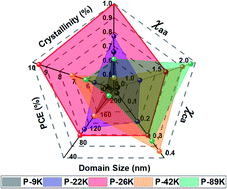Tuning the molar mass of P3HT via direct arylation polycondensation yields optimal interaction and high efficiency in nonfullerene organic solar cells†
Abstract
Due to the simple structure and excellent scalability, regioregular poly(3-hexylthiophene) (P3HT) has become much more popular as a low-cost donor polymer partner with the emerging nonfullerene acceptors in recent years. Presently, the application and the molar mass dependence of direct arylation polycondensation (DArP) prepared P3HT in fullerene-free organic solar cells have not been explored yet. In this work, five batches of P3HT with weight-average molar mass ranging from 8.9 kg mol−1 to 89.1 kg mol−1 were successfully prepared via DArP, with the aim to detail the interaction–performance relationships in the state-of-the-art P3HT:nonfullerene photovoltaic blend, namely P3HT:ZY-4Cl. Our thermodynamic analysis revealed that the amorphous–amorphous interaction parameters strongly depend on the P3HT molar mass and can be varied by a factor of 2.75. Owing to the best π–π stacking order deduced from grazing incidence X-ray diffraction and the smallest domain size, the blend based on the medium molar mass batch (25.5 kg mol−1) delivered the highest current density, fill factor, and power conversion efficiency up to ∼10% among the five systems. Our study confirmed that DArP is an effective protocol for the synthesis of P3HT for efficient non-fullerene polymer solar cells and the established relationships can be applied to screen the best batch for P3HT-based organic photovoltaics.

- This article is part of the themed collections: Journal of Materials Chemistry A Lunar New Year collection 2022, Journal of Materials Chemistry A Emerging Investigators and 2021 Journal of Materials Chemistry A most popular articles


 Please wait while we load your content...
Please wait while we load your content...